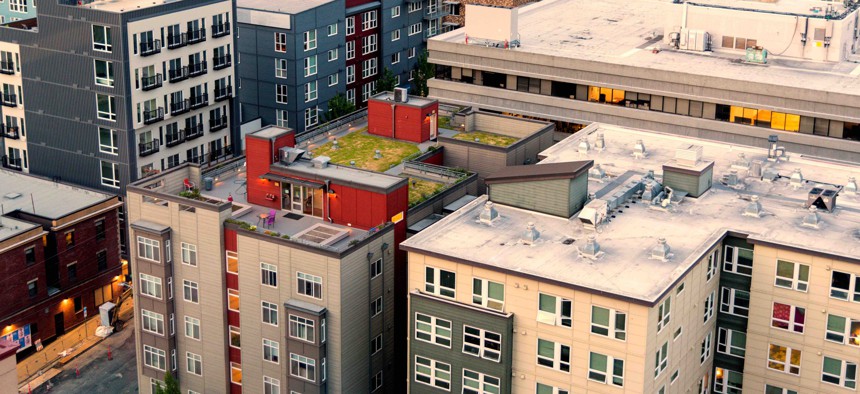Financial Pressure From Rent is Moving Up the Income Ladder

Shutterstock
"Ultimately, we're in a rental affordability crisis,” says a researcher who worked on a new report that looks at this and other rental housing trends.
Rent is increasingly posing an outsized financial burden for households earning between $30,000 and $75,000 a year, according to new research from the Harvard Joint Center for Housing Studies.
The 2020 edition of the America’s Rental Housing report highlights other trends as well. For instance, it's become more common for higher-earning households to rent, and newly constructed rental housing tends to be built for the pricier end of the market. But the researchers flagged the way that difficulties with housing affordability are “climbing the income ladder” as a key finding.
Among households earning between $30,000 and $44,999 annually, the share of “cost-burdened” renters (those spending more than 30% of their income on rent and utilities) increased by about 5.4 percentage points between 2011 and 2018, to around 56%.
Over that same timeframe, the share of cost-burdened renters rose by about 4.3 percentage points, to around 27%, among households earning $45,000 to $74,999.
The pressure on middle-income renters can be especially high in expensive coastal cities like San Francisco and New York. But Whitney Airgood-Obrycki, a researcher with the Joint Center for Housing Studies, said the issue is not confined to those places.
"This is a trend that we're seeing playing out in metros of all sizes across the country,” she said at an event last week.
The report documents how the spread of rental cost burdens up the income scale has coincided with an ongoing decline in lower-cost rentals. Despite the generally healthy economy, earnings growth has not kept up with the cost of rising rents, researchers found.
For a household earning $45,000 annually to meet the 30%-of-income affordability standard, they’d need to pay about $1,125 or less per month in housing costs.
While middle-income renters are facing fast-rising housing cost burdens, Airgood-Obrycki said it’s important to note that there are major housing affordability concerns for the lowest-income renters.
In 2018, upwards of 80% of renters earning under $15,000 a year were spending at least 30% of their income on housing.
"Ultimately, we're in a rental affordability crisis,” Airgood-Obrycki said.
Between 2004 and 2016, the nation saw a significant run-up in rental demand, with the addition of more than 10 million renter households and the rentership rate increasing to about 36%. Currently, rentership appears to be at somewhat of a plateau with the number of renter households holding at around 43.5 million for about four years.
But rental demand among those earning $75,000 a year or more has been strong compared to early 2000s, when lower-income households drove more of the growth.
“That's keeping markets tight and it's also changing the demographic profile of renters,” said Airgood-Obrycki. “This is a really enormous shift and it's having a big impact on rental markets.”
She noted that many of the higher-earning renter households are college-educated, young married couples who look a lot like the first-time homebuyers of years gone by.
There are different theories as to why more households like this are choosing to rent rather than buy—for example, maybe it’s a matter of preference, or maybe the costs of buying a home are too high. Homeownership growth since 2010 mostly occurred for households who earn at least $150,000 per year, with much of the growth happening for those earning $200,000 or more.
But setting aside the causes of the rising tide of higher-income renters, the end result is that more people with more money are seeking rental housing. Households earning $75,000 or more now account for nearly a quarter of all renters, a six percentage point increase since 2004.
On the supply side, there is new housing being built, with new rental construction near its highest levels in three decades, according to the report. "Importantly though, a lot of this new construction has been geared toward the high end,” Airgood-Obrycki said.
The report says that the median asking rent for unfurnished, new units completed during 2018 and 2019 was about $1,600 a month. That’s up 37% compared to units completed in 2000 after taking inflation into account. Meanwhile, about 1-in-5 newly built apartments had asking rents that were $2,450 or more. One big reason that rental costs are on the rise is that many of the new rental units are being built in major metropolitan regions where land is expensive.
As of the third quarter of 2019, the nation had seen 21 consecutive quarters of rents rising by more than 3% year over year, the Harvard researchers found. Adjust for inflation and that statistic increases to 29 quarters, just one short of the longest stretch dating back to the 1940s.
Over this roughly seven-year period of rent growth, rents have increased by about 27%, the report also notes, roughly four times faster than the prices of all other goods.
A full copy of the report can be found here.
Bill Lucia is a senior reporter for Route Fifty and is based in Olympia, Washington.
NEXT STORY: Where in the World is Kansas City?






